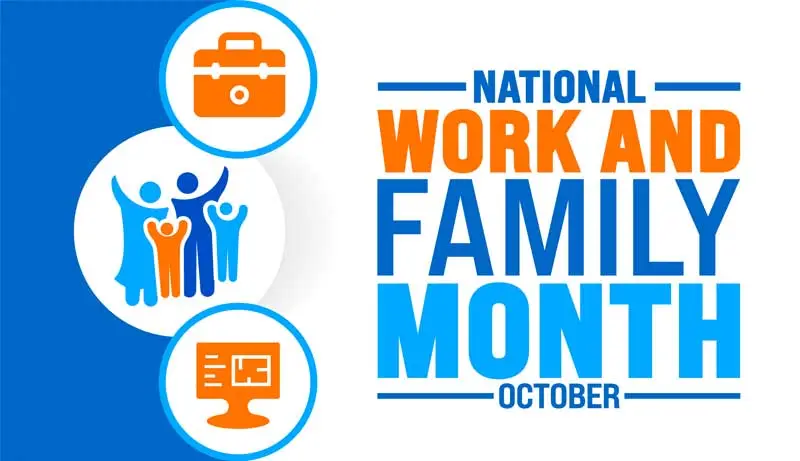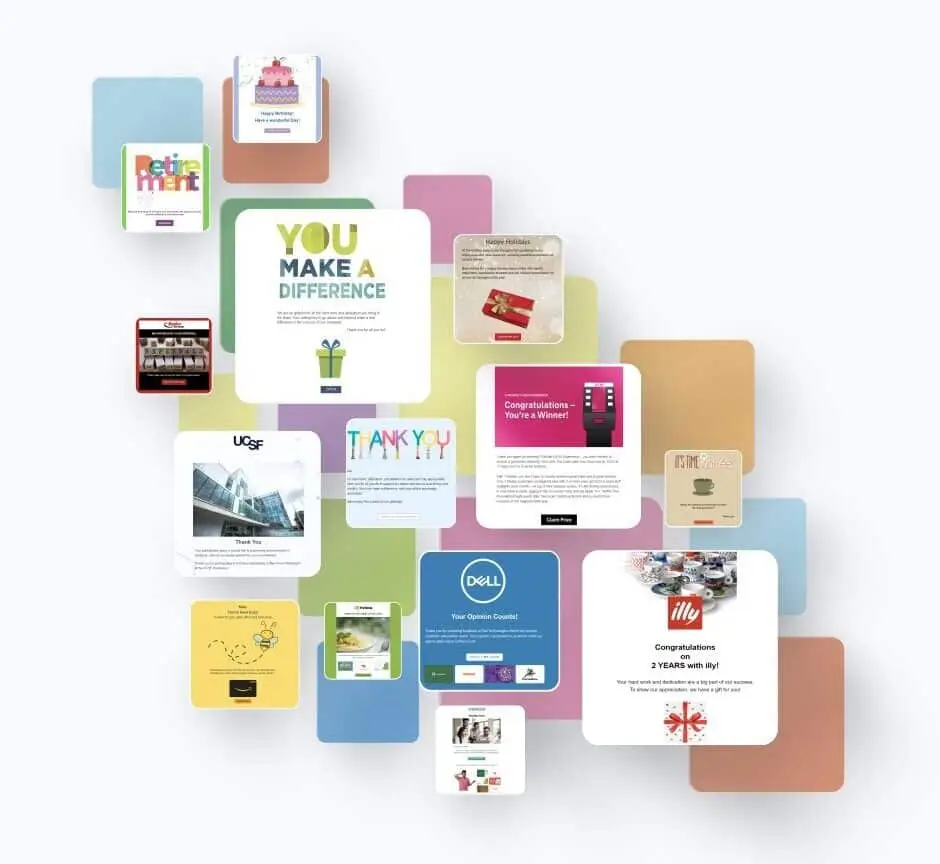National Work and Family Month, also known as Work and Family Awareness Month, is an annual observance that aims to promote a healthy work-life balance and highlight the importance of supporting employees’ personal and family needs.
There are a number of ways for you to participate by helping employees and assisting them in finding a healthy work-life balance.
Recognizing and appreciating employees’ efforts through policies like flexible work arrangements, time off and employee recognition can go a long way in fostering a positive work environment.
Small gestures like gift cards for food delivery, dining out, home movie night, or outings are popular for supporting busy families.
National Work and Family Month serves as a reminder for employers and employees alike to prioritize work-life balance and create supportive environments where both personal and professional responsibilities can be effectively managed.

National Work and Family Month is observed in October. It’s an annual event with the goal of promoting a healthy work-life balance. The month highlights the challenges of juggling work and family, while emphasizing the importance of flexibility, mental well-being, and reducing stress.
The U.S. Senate passed a resolution in in 2003 formalizing the observance to encourage employers to implement policies that support employees in balancing professional responsibilities with personal and family needs.
It’s a great month for companies and organizations to offer family-friendly initiatives such as flexible work hours, stress management workshops, employee recognition events and other policies that support employees. Creating a supportive work environment helps employees manage both their work and family responsibilities effectively.
National Work and Family Month aims to promote happier, healthier, and more engaged employees, benefiting both individuals and their workplaces.
Here is an example of Work and Family Month resources in use at the National Institutes of Health

Supporting employees in managing their professional and personal lives promotes a healthy work-life balance. Here are a few ways where policies can help.
Flexible Work Schedules
Options like flexible hours, remote work, or compressed workweeks can give employees more control over their time.
Regular Breaks
Encourage employees to step away from their desks, take lunch breaks, or go for walks to clear their minds.
Remote and Hybrid Work Options
Flexible work options can reduce commute stress and give employees more time for family and personal activities.
Time Management
Provide training or workshops on effective time management, and setting realistic goals.
Build a Supportive Culture
Train and encourage managers to respect work-life balance by respecting employee boundaries, and showing empathy for employees’ personal commitments.
Mental Health Resources
Offer access to mental health support, such as counseling services and wellness programs.
Recognize and Reward Efforts
Recognition helps employees feel valued.
Employers can create a more balanced, healthy, and productive work environment with a few simple actions. (Interested in Wellness Month?)

Think outside the usual corporate model and explore unique ideas to engage employees during National Work and Family Month. Suggestions could include virtual or in-office family days, stress-relief workshops, flexible Fridays, or family photo contests. Fun activities like a “bring your pet to Zoom day” or scavenger hunts can add some lightheartedness to the workplace.
Flexible Fridays and Shortened Workweeks
Offer flexible hours or half-day Fridays on a regular basis to encourage employees to spend more time with their families or pursue personal activities.
Bring Your Family to Work Day (Virtually or In-Person)
Allow employees to bring their children or family members to work for a fun, interactive experience. If virtual, organize a session where kids or family members can meet coworkers, see what their parents do, and participate in light activities.
Work-Life Balance Challenges
Offer incentives to employees for agreeing to balance work and personal time, with prizes for participants, such as family-themed gift cards for movie nights, dining, or entertainment.
Wellness Wednesdays
Dedicate Wednesday at lunch time to wellness activities like group meditation, desk yoga, or guided relaxation breaks.
Parental Leave Awareness
Promote awareness around your company’s parental leave policies and encourage employees to take time off when needed.
Family-Friendly Volunteer Opportunities
Organize volunteer days where employees and their families can contribute to a cause together.

Work-life balance is the ability to effectively manage the demands of both professional responsibilities and personal life.
It’s about finding the right equilibrium where neither work nor personal obligations overwhelm.
When balance is achieved, people can perform at their best in their jobs while also enjoying meaningful personal lives.
A crucial aspect of work-life balance is managing time effectively. Setting clear boundaries separates work time from personal time, which helps individuals avoid burnout.
Establishing set times for work and for family and relaxation, helps maintain a healthy separation and builds a healthy work-life balance.

Focus on the most important tasks first, and don’t hesitate to delegate when possible. This can help reduce stress and keep you from feeling overwhelmed by an unrealistic workload.
Step away from your desk periodically to recharge. Breaks can help refresh your mind, reduce stress, and improve focus when you return to work.
Create a daily routine that includes time for both work and personal activities. Scheduling time for exercise, hobbies, family, and relaxation can help you maintain a healthier balance.
Take advantage of flexible work arrangements, such as remote work, flex hours, or compressed workweeks, if available. This can help you better manage your personal commitments.
Make time for activities that improve your well-being, such as exercise, meditation, or hobbies. Prioritizing self-care is essential to reducing stress and maintaining mental and physical health.
Stay focused on work during designated hours to avoid carrying tasks over into personal time. Limiting distractions can increase productivity, allowing you to finish work more efficiently.
Being organized can help you manage your time more efficiently and reduce last-minute stress. Keep a to-do list or planner to organize tasks and deadlines.
Regularly schedule vacation time or mental health days to recharge. Even a short break can improve overall productivity and well-being.
Open communication about workload, flexibility, or adjustments can lead to solutions that benefit both you and the company. Speak to your manager or HR if there is any difficulty maintaining balance.
Recognizing and appreciating employees’ efforts through small gestures like gift cards for movies and local eateries, along with personalized thank-you notes can go a long way to engaging employees.
Offer occasional family passes or discounts to local attractions like zoos, theme parks, or museums.
Provide family movie nights, with tickets to a local theater or by providing streaming gift cards for at-home viewings.
Encourage a family dinner. Gift cards to local dining establishments, or gift cards for food delivery services are an easy way to accomplish this.
Create a “Take your child/family/dog to Work Day” and keep it fun. Provide lunch and demonstrations of what your organization accomplishes at work.

Helping employees understand the importance of a healthy work-life balance is important for overall success.
A beneficial work-life balance, health and wellness go hand-in-hand in ensuring overall life satisfaction and overall well-being.
A healthy work-life balance makes employees more productive and efficient. Absenteeism is less likely, which means fewer disruptions.
Fewer sick days maintains productivity, cuts cost and reduces the burden on employees who cover for missing colleagues.
Healthy employees are usually happier and more satisfied. Higher satisfaction and higher employee retention is one benefit to high morale and healthy employees.
Employees with a positive work-life balance that feel good physically are more likely to interact positively with their colleagues.
New ideas and better ways to accomplish tasks comes form employees that are positive. Healthy employees are better able to contribute new ideas and solutions.
Organizations that promote a good work-life balance are more likely to be considered caring and considerate by employees, which results in higher job satisfaction and engagement.
National Work and Family Month serves as a reminder to create and to foster work environments that allow employees to manage both their professional and personal responsibilities. Organizations should recognize the challenges of juggling work and family and put in place strategies that prioritize well-being and reduce stress.
Many organizations choose to implement initiatives aimed at boosting work-life balance, including flexible work schedules, remote work options, stress management workshops, and time management seminars.
Work-life balance initiatives can provide employees with valuable tools and resources to navigate their responsibilities more effectively, ultimately reducing stress and improving overall job satisfaction.
Happier, healthier employers are typically more engaged with their work. That benefits everyone; the employee, the organizations and ultimately customers.


A design session is the perfect way to show you how TruCentive can help you realize your rewards, gifts, or payout goals in a real-world scenario, building a complete project with everything from your logo, design options, and messaging to incentive selection, deliveries, and reminders.
When we’re done, you’ll:


If you’re ready to start designing on your own, sign up and start sending samples. There’s no credit card required to start exploring your creative side!

Use powerful features to quickly create professional-looking incentive deliveries

With a TruCentive subscription, you get technical support for all your team members so you can get back to your project fast

Eliminate the time and frustration managing the procurement, delivery, and management of your rewards and incentives deliveries